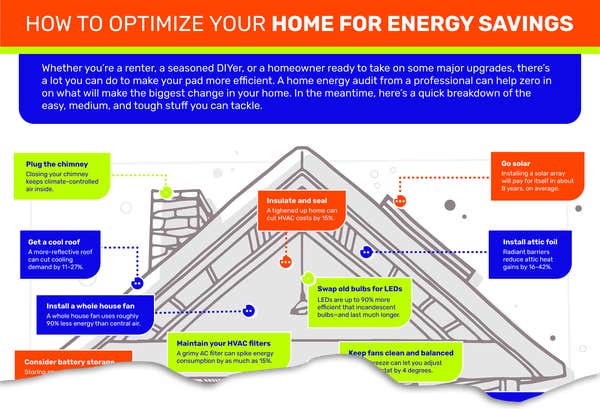Hey team, and welcome to a special edition of one5c! Today, we’re rolling out our most ambitious project yet: the one5c guide to making your home more efficient. It’s full of tips, tricks, projects, and simple hacks to dial down your home’s power use—and those utility bills. Lest we forget: Residential energy consumption accounts for around 20% of planet-warming greenhouse emissions in the U.S.
We’d love to come at ya with a splashy headline like “Your 10-step guide to decarbonizing your home.” But we’re about change that anyone can make. Yes, you can swap your natural-gas furnace for an electric one, but that’s only part of the picture. Most people in the U.S. are tied to grids that deliver our electricity from fossil-fueled plants—though renewables are taking up an increasingly large piece of that pie year by year. Fixing the U.S.’s mix isn’t something you can put on your to-do lists. (That’s what voting for policymakers who prioritize and incentivize the renewables transition is for!) What’s that leave us with? Finding ways to minimize the amount of dead-dinosaur-powered juice we use on a daily basis.
As always, our goal is to zero in on the changes that have the biggest impact. We looked at what uses the most energy in American homes and figured out how to make those systems hoover up less. The bulk of our advice centers on climate control, because together heating and cooling our homes accounts for 43% of residential draw. And it turns out there’s a lot you can do to change that—and we’re not only talking about big stuff. Caring for your ceiling fans, cleaning out your AC filter, and covering up your windows are all things you can do today. All that’s before you start exploring major projects like upgrading insulation or switching your HVAC to a heat pump.
We could go on…
This work, perhaps even more so than our guides on plastic pollution and food waste, never really ends. To be honest, we had to stop ourselves from continuing to add more and more topics and tips and hacks to this batch.
More is coming, but our priority is to not overwhelm you. That’s why we also distilled the best pieces of advice into one handy guide. There’s definitely something in there you can start doing right now, because a good chunk of this stuff is free, and totally doable even if you don’t own your home. Let’s get to it. —Sara Kiley & Corinne
THE ROUNDUP
In the news this week
About 30% of the raw material used to make new Lego bricks is coming from what the toy company calls “mass balanced” sources, the firm’s CEO told the Financial Times. The portion of the plastic they use that doesn’t come from fossil-fuel sources taps a mix of recycled and renewable resins, such as ones made from used cooking oil.
Instagrammer @accidentally_vegan_canada has spotted plant-based white cheddar Cheetos! While FritoLay tells our buds at VegNews that the rollout is still a work in progress, it’s a good reminder that there are plenty of snack options to heat up your Labor Day weekend—but not the planet. If you’re craving that cheesy goodness, these puffs from Hippeas are a popular (and tasty) alternative.
If you’re a racing fan, you might have heard about Formula 1’s push toward more sustainable racing fuels. Thing is, the petrol the cars burn during a race represents only a tiny portion of the emissions associated with the racing series. What would it take for F1 to really call itself “green”? one5c publisher Joe Brown lays it all out on the newest episode of the James Allen on F1 podcast.
A new ad from Big Oil’s marketing machine is casting California’s climate policies as bad for lower-income families—and conveniently ignoring the role the industry plays in perpetuating the pollution and emissions that stand to harm those same communities, reports Capital & Main. The spot pins rising energy prices on the renewables transition (not so!) and presents the fossil-fuel industry as a friend to working families. In reality, though, the group’s lobbying centers more on defeating emission-curbing bills than on equity.
Also in California, the city of Oakland has rolled out the first all-electric school bus fleet for the 2024-2025 school year. Nationally, the big yellow kid haulers make up the largest public transportation fleet in the country, and so a switch off of gas-burners stands to have major impacts on air pollution. But there’s more: The buses can also act as giant mobile batteries. Read more about how that works here.

